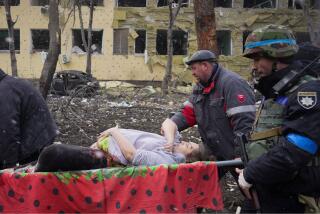Dwight Long; Filmed WWII Action, Sailed the World
- Share via
It was every man’s dream. And he did it when he was young.
On his 21st birthday, he boarded a 32-foot ketch to sail around the world.
Six years and six days later, he came back--just in time to reload his film camera for the Pacific action during World War II.
Dwight Stanley Long, lifetime mariner, adventurer and pioneering documentary filmmaker, died of pneumonia July 3 in Santa Monica. He was 89.
Although Long’s efforts predated cable television’s Travel, History and Discovery channels, his travel footage of a bygone era and his dramatic war scenes have been widely viewed and remain readily available.
The color film he made of his youthful around-the-world prewar adventure, titled “Sailing All Seas,” was converted to video a decade ago and is sold at such seafarer venues as the Los Angeles Maritime Museum in San Pedro.
The daring footage Long shot aboard the Yorktown II and other aircraft carriers during the last two years of World War II was seen in theater newsreels across the country at the time and continues to pop up in sea epics about the war. One of his scenes repeatedly used by Hollywood shows a Hellcat fighter plane crashing onto the Yorktown and breaking in half, and the pilot climbing out safely.
At the former Navy lieutenant commander’s suggestion, Long’s scenes of the Battle of the Philippine Sea and other encounters were made into the Academy Award-winning documentary “The Fighting Lady” by 20th Century Fox, directed by Louis de Rochemont and narrated by actor and former Navy Lt. Robert Taylor.
“There wasn’t any Betty Grable or Clark Gable in it,” Long told The Times in 1993 when the documentary was shown at a Navy League fund-raiser in San Pedro. “It was just men fighting a battle.”
His war footage also underpinned the television documentary “Victory at Sea,” still available on video.
Long was assigned to the Yorktown II (the original was sunk at the Battle of Midway) from its launch in 1943 under orders to film aircraft carrier warfare--the men, the armaments and the combat. With two assistants, he documented the Pacific war on 16-millimeter color film from the ship’s deck and Navy fighter cockpits. Periodically, he flew to Hawaii to develop the film, keeping one copy and handing one to military officials for theater newsreels.
When the documentary film premiered, a Time magazine reviewer raved: “For violent air action and for pure visual magnificence, ‘The Fighting Lady’ is not likely ever to be beaten.”
Long earned a Legion of Merit award for his work.
His unusual wartime assignment, in famed photographer and former Navy Capt. Edward Steichen’s Pacific Naval Photographic Unit, stemmed directly from Long’s freshly proven cinematography talents during his 1934-1940 circumnavigation of the globe.
Born and reared in Seattle, Long studied journalism at the University of Washington and planned to work his watery way around the world, sending dispatches to newspapers and magazines as he sailed along.
The six-year odyssey in his ketch, the Idle Hour, took Long from Seattle south to Los Angeles, then toward the sunset in Hawaii and the South Pacific, including Tahiti and Samoa. He then went on to New Zealand, Australia, New Guinea, Bali, Singapore, across the Bay of Bengal to Ceylon (now called Sri Lanka), to the Red Sea and the Suez Canal to Egypt, where he sailed up the Nile to Abu Simbel before the Aswan Dam was built.
He crossed the Mediterranean, rounding Gibraltar amid a gale and rumors of war, and sailed up the coast of Spain, where he was jailed briefly as a suspected would-be assassin of Francisco Franco.
Long continued on to London and then across the Atlantic to New York, where a hurricane smashed the Idle Hour into a sea wall. After repairs, the ketch sailed on to the West Indies, through the Panama Canal to the Galapagos Islands, Baja California, Los Angeles and home to Seattle.
The skipper took on various sailing mates as he wended west, including a half-blind septuagenarian postman in Hawaii and a 300-pound English tea planter in Ceylon. Most touchingly, he hired on 15-year-old Timi Tafaoora in Bora Bora, introduced him to his first motion picture, horse and trolley car in Auckland, New Zealand, and, after two years, lost him to pneumonia in Ceylon. Long’s dog, Hugo, washed overboard along with the mainmast during a storm in the South Pacific.
At journey’s end, Long not only issued his film “Sailing All Seas,” but wrote a book, “Seven Seas on a Shoestring,” which went through several editions. After the war, he returned to Tahiti to make a docudrama about native life, “Tanga Tiki.”
In later years, Long utilized his cache of film made during the 1930s and 1940s to create several travel documentary films, which he narrated into the 1970s as “Armchair Adventures” at UCLA’s Royce Hall. A Times reviewer, commenting at Long’s 1959 presentation of his documentary on Spain, rated certain scenes as “some of the finest ever seen in a travelogue.”
Long also owned a chain of jewelry and specialty shops at Disneyland, the Queen Mary and Ports O’ Call Village.
He is survived by his brother, Bob, of Alaska; and his sister, Erna McKenzie of Oregon.
A memorial service is scheduled for 11 a.m. Monday at Maritime Museum, Berth 84, at the foot of 6th Street in San Pedro.
More to Read
Only good movies
Get the Indie Focus newsletter, Mark Olsen's weekly guide to the world of cinema.
You may occasionally receive promotional content from the Los Angeles Times.










